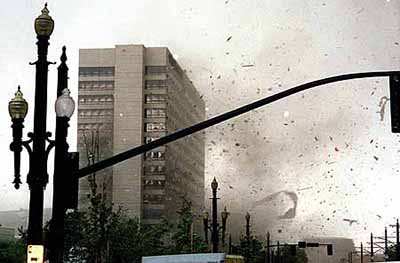Is your Laboratory Prepared for Severe Weather?

The image above is from a tornado touching down in Salt Lake City. Cities and university campuses are not immune to tornadoes and severe weather can threaten the safety and operation of research laboratories at any time, and with short notice. As with any emergency, preparedness is your best defense. You should have plans already in place, well in advance of a severe weather event, to ensure the protection of valuable research equipment, specimens and data. A Business Continuity Plan is a valuable tool to prepare your laboratory for any emergency, not just severe weather emergencies, and I hope everyone has such a plan already in place. I have put together the following list to help you prepare your laboratory before any emergency occurs.
Consider the following:
-
You should have an updated Business Continuity Plan in place.
-
All emergency contact information should be updated in the IU Notify system.
-
All contact information on your laboratory signage should be correct.
-
Ensure you have the current Emergency Procedures Handbook posted in the laboratory.
-
All chemicals should be tightly sealed, segregated and stored properly.
-
All fume hoods should be closed when not in use.
-
Laboratories with outside windows should ensure water reactive chemicals, radioactive materials and biological hazards are stored in an area away from the windows that offers protection from rain and wind should a window break, such as in an enclosed cabinet.
-
Plans should be in place to protect any laboratory documents from water damage such as lab notes, computer discs, research documentation or any other items that cannot be replaced.
-
Lab personnel should ensure critical cell lines are frozen and placed into different locations and conditions to ensure continued maintenance. Ultra-low freezers and Liquid Nitrogen vessels can be used, and I would also suggest you spread your critical cell lines throughout the Department using multiple resources, if possible.
-
Ultra-low freezers should be powered by emergency generator, identified by the red emergency outlets, and monitored by alarm.
-
All essential equipment that cannot be shut down should be plugged into the red emergency power outlets.
-
BSL3 Laboratory Directors should already have Standard Operating Procedures to follow in case of loss of utilities such as electricity and HVAC. Work in these facilities should be discontinued during a weather emergency.
-
Compressed gas cylinders should be secured at all times and stored appropriately.
-
Back-up computer files, make more than one copy and store in several different locations.
Once a hazardous weather warning is issued, the following plans should be implemented in each laboratory.
-
Complete existing experiments to a termination point. Do not start any new experiments. Shut down equipment if hazardous conditions may result from loss of utilities ( ie., loss of coolant, vacuum, steam etc..).
-
Be prepared to terminate experiments immediately if conditions deteriorate.
-
Breakable items or items that may become airborne in heavy winds should be moved away from outside windows.
-
Ensure you have your University issued ID with you.
-
Complete any animal surgeries in progress and be prepared to terminate surgery immediately if conditions deteriorate.
-
Confirm that all laboratory animals are placed in appropriate housing.
-
Once a tornado warning is issued you should immediately suspend all laboratory procedures, shut all fume hoods, tightly seal all chemical containers and seek shelter immediately. Stay away from windows and exterior doors. Basements, interior hallways on the lower floors and small interior rooms on the lower floors are the best locations to seek shelter.
It is essential that we prepare for violent weather in Indiana. Please review the above guidelines and ensure you are prepared to act should severe weather arrive at your door. 
|